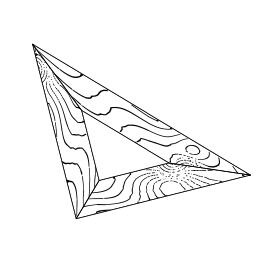19.3: Constructions with a set-square
- Page ID
- 23705

A set-square is a construction tool shown on the picture — it can produce a line thru a given point that makes the angles \(\tfrac\pi2\) or \(\pm\tfrac\pi4\) to a given line and it can be also used as a ruler; that is, it can produce a line thru a given pair of points.
Trisect a given segment with a set-square.
- Hint
-
Note that with a set-square we can construct a line parallel to given line thru the given point. It remains to modify the construction in Exercise 14.2.1.
Let us consider set-square constructions. Following the same lines as in the previous section, we can define set-square constructible numbers and prove the following analog of Theorem 19.2.1:
Theorem Assume that the initial configuration of a geometric construction is given by the points \(A_1=(0,0)\), \(A_2=(1,0)\), \(A_3=(x_3,y_3),\dots,A_n=(x_n,y_n)\). Then a point \(X=(x,y)\) can be constructed using a set-square construction if and only if both coordinates \(x\) and \(y\) can be expressed from the integer numbers and \(x_3\), \(y_3\), \(x_4\), \(y_4,\dots,x_n\), \(y_n\) using the arithmetic operations "\(+\)", "\(-\)", "\(\cdot\)", and "\(/\)" only.
Let us apply this theorem to show the impossibility of some constructions with a set-square.
Note that if all the coordinates \(x_3,y_3,\dots,x_n,y_n\) are rational numbers, then the theorem above implies that with a set-square, one can only construct the points with rational coordinates. A point with both rational coordinates is called rational, and if at least one of the coordinates is irrational, then the point is called irrational.
Show that an equilateral triangle in the Euclidean plane has at least one irrational point.
Conclude that with a set-square, one cannot construct an equilateral triangle with a given base.
- Hint
-
Assume that two vertices have rational coordinates, say \((a_1, b_1)\) and \((a_2, b_2)\). Find the coordinates of the third vertex. Use that the number \(\sqrt{3}\) is irrational to show that the third vertex is an irrational point.


